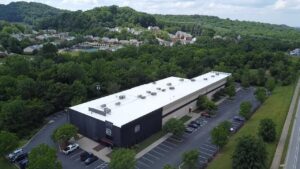
In the world of commercial roofing, steep slope roofs offer a unique set of advantages. Understanding the key features and benefits of steep slope roofing can help business owners make informed decisions when it comes to their commercial roofing needs.
Understanding Steep Slope Roofing
Steep slope roofs, also known as pitched roofs, have a slope greater than 3:12, meaning that for every 12 horizontal inches, the roof rises 3 inches or more. This type of roofing system is commonly found in residential buildings, but it is also popular in commercial constructions.
When it comes to steep slope roofing, the pitch of the roof plays a crucial role in determining its performance. The steep angle of these roofs not only adds architectural interest but also serves a functional purpose. The steep slope allows for efficient water drainage, preventing water from pooling and potentially causing leaks. This design feature is particularly important in areas prone to heavy rainfall or snow accumulation.
Key Features of Steep Slope Roofs
Steep slope roofs offer several key features that make them a desirable choice for commercial structures. Firstly, their design allows for efficient water drainage, reducing the risk of water pooling and subsequent leaks. Additionally, steep slope roofs provide enhanced ventilation, which can help regulate attic temperatures and improve energy efficiency.
Moreover, the steep slope of these roofs creates additional usable space in the attic or upper levels of a building. This extra space can be utilized for storage or even converted into living areas, adding value to the property. The steep pitch also allows for easy installation of skylights or dormer windows, bringing natural light into the building and enhancing the overall aesthetics.
Benefits of Steep Slope Roofing
There are numerous benefits associated with choosing steep slope roofs for commercial applications. One of the main advantages is their durability. Steep slope roofs are designed to withstand harsh weather conditions, including heavy rain, snow, and high winds. They also have a longer life expectancy compared to other roofing systems, reducing long-term maintenance and replacement costs.
Steep slope roofs also offer aesthetic appeal, as the variety of materials available allows for customization to match any architectural style. This can enhance the overall look and curb appeal of commercial buildings, leaving a lasting impression on clients and visitors.
Overall, steep slope roofing combines functionality with aesthetics, making it a popular choice for a wide range of commercial applications. The unique design features and benefits of steep slope roofs contribute to their longevity and performance, ensuring a reliable and visually appealing roofing solution for commercial buildings.
Materials Used in Steep Slope Roofing
Several materials are commonly used in the construction of steep slope roofs. These materials play a crucial role in determining the roof’s durability, appearance, and performance.
When considering the materials for a steep slope roof, it’s essential to take into account not only the aesthetic appeal but also the practical benefits each material offers. The right choice can enhance the overall look of a structure while providing long-lasting protection against the elements.
Asphalt Shingles
Asphalt shingles are the most popular choice for steep slope roofs due to their affordability, versatility, and ease of installation. They come in a wide array of colors and styles, allowing for design flexibility. Asphalt shingles are also fire-resistant and have a relatively long lifespan.
One of the key advantages of asphalt shingles is their cost-effectiveness. They provide a budget-friendly option without compromising on quality or durability. Additionally, advancements in technology have led to the development of impact-resistant asphalt shingles, making them even more resilient against harsh weather conditions.
Metal Roofing
Metal roofing is another excellent option for steep slope roofs. It offers exceptional longevity, as metal is highly resistant to damage from the elements. Metal roofs are also eco-friendly, as they are often made from recyclable materials. They provide excellent energy efficiency and can help reduce cooling costs.
One of the standout features of metal roofing is its sustainability. Metal roofs are not only durable but also fully recyclable at the end of their lifespan, making them a more environmentally conscious choice. Additionally, metal roofs are lightweight, putting less stress on the structure of a building and allowing for easier installation.
Slate and Tile
Slate and tile roofing are commonly chosen for their elegance and aesthetic appeal. These materials are incredibly durable and can last for decades with proper maintenance. Slate and tile roofs offer excellent fire resistance and can withstand extreme weather conditions.
One of the distinguishing characteristics of slate and tile roofing is their timeless beauty. The natural variations in color and texture of these materials add a touch of sophistication to any architectural style. In addition to their visual appeal, slate and tile roofs are known for their exceptional durability, often outlasting other roofing materials by several decades.
Installation Process of Steep Slope Roofs
The installation process for steep slope roofs involves several considerations and steps that should be followed meticulously to ensure a successful and long-lasting outcome.
Pre-Installation Considerations
Prior to installation, it is crucial to conduct a thorough inspection of the existing roof structure. Any underlying structural issues should be addressed to ensure the new roof is properly supported. It is also important to choose the right materials and assess the local climate and environmental factors that may influence the roof’s performance.
Steps in the Installation Process
The installation process typically begins with the removal of the old roofing material and any necessary repairs to the underlying structure. The roof deck is then prepared, and underlayment is applied. Finally, the chosen roofing material is installed, starting from the bottom edges and working upward. Proper flashing, ventilation, and gutter installation are key components of the process, ensuring the roof’s longevity and performance.
Maintenance and Repair of Steep Slope Roofs
Maintaining and repairing steep slope roofs is essential to prolong their lifespan and prevent costly damage. Regular maintenance can help identify potential issues early on and prevent them from turning into major problems.
Regular Maintenance Tips
Regularly inspecting the roof for signs of damage, such as missing or damaged shingles, is the first step in maintenance. Cleaning gutters and downspouts, removing debris, and trimming overhanging branches can prevent water buildup and reduce the risk of damage caused by falling branches. Additionally, scheduling professional inspections at least once a year can help detect and address any underlying issues.
Identifying and Repairing Damage
If damage is identified during a maintenance inspection, prompt repairs are necessary to prevent further deterioration. Whether it’s replacing missing or damaged shingles, repairing leaks, or addressing flashing issues, it is essential to hire a professional roofing contractor experienced in steep slope roof repairs.
Choosing a Commercial Steep Slope Roofing Contractor in Tupelo
When it comes to choosing a commercial steep slope roofing contractor in Tupelo, there are several factors to consider to ensure a successful and high-quality installation or repair.
What to Look for in a Contractor
First and foremost, make sure the contractor is licensed and insured. This provides protection for both you and the contractor in case of accidents or unforeseen issues. Additionally, look for contractors with experience in installing and repairing steep slope roofs specifically, as this expertise is crucial for a successful project. Reading reviews and seeking referrals can also help gauge the contractor’s reputation and customer satisfaction.
Questions to Ask Your Potential Contractor
Before hiring a contractor, ask questions about their previous projects, materials they recommend, and warranties they offer. Inquire about their safety practices and whether they have a dedicated project manager overseeing the work. Request a written estimate and timeline for the project to ensure all expectations are clear from the start.
In conclusion, commercial steep slope roofing offers numerous benefits, including efficient water drainage, enhanced ventilation, durability, and aesthetic appeal. By understanding the materials, installation process, and maintenance requirements, business owners in Tupelo can make informed decisions when it comes to their commercial roofing needs. Choosing a reputable and experienced contractor is essential to ensure a successful and long-lasting roofing solution.
Ready to ensure your Tupelo commercial property is equipped with a steep slope roof that offers superior protection and aesthetic appeal? Look no further than Commercial Roofing Rana. With our expertise in serving a diverse range of commercial buildings across the Mid-South, including Tennessee, Kentucky, Mississippi, and Arkansas, we’re committed to delivering top-tier roofing services tailored to your needs. Our licensed professionals use Duro-Last roofing systems, ensuring a perfect fit and unmatched defense against water damage. Since 1983, we’ve been the trusted choice for industrial managers, store owners, and municipal building caretakers. Don’t wait for the next rainstorm to test your roof’s resilience. Schedule Now! and let Commercial Roofing Rana fortify your business with our proven roofing solutions.
